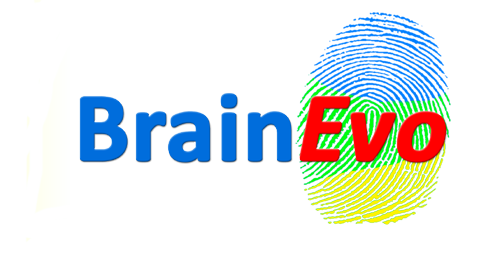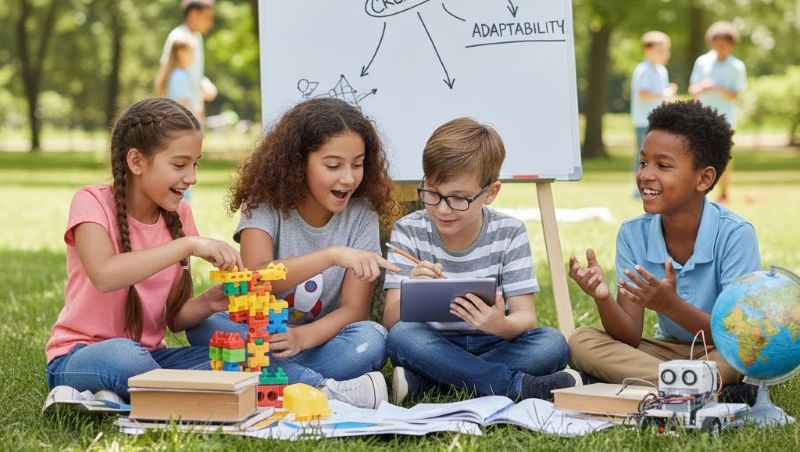
Visual Spatial Intelligence : Understanding The Basics
September 8, 2022
More on Naturalistic in Art
September 10, 2022What is Bodily-Kinesthetic Intelligence?
The theory of multiple intelligences was introduced by psychologist Howard Gardner in 1983 in his book Frames of Mind. Gardner argued that intelligence is multifaceted and not solely reliant on linguistic or mathematical abilities. Bodily-kinesthetic intelligence emerged as one of the nine intelligences in his model, spotlighting physical skill as a crucial aspect of human capability.
As the explanation of the theory of multiple intelligence by Howard Garden, an expert from Harvard who believe that every person is blessed with the intelligence. So, there is the one that is called as ‘stupid’. It is because each person has their own intelligence. One of the intelligence is Bodily-kinesthetic Intelligence. This is the intelligence where the children will use their all parts of body in expressing their ideas and feelings to other people. Here, the children will be more active.
Yup, Bodily-kinesthetic Intelligence is the intelligence of using the body on delivering the ideas, expressing feelings, and the skills of using hands in creating and modifying one object to other shapes without the same shape as the first object. Here, it is about the physical abilities. For examples are coordination, balance, strength, skills, flexibility, speed and also the ability to receive the sensory stimuli. Here, you will understand that the children will not be able to learn while sitting quietly.
There are some abilities that can indicate your children have this Bodily-kinesthetic Intelligence. First, it is about the ability of moving the part of body. It looks easy for many children. But sure, this is the first indication. Second, the children are able to manage their body’s balance. Sometimes, there are children who have the ability to move their part of body but they have the balance especially when they are walking. Third is the ability to manage the body flexibility and the last is ability to keep the health.
There are also some activities that can stimulate the Bodily-kinesthetic Intelligence of the children. You are better to have the following ideas for your children. First, it is the sport games. You can try with the games of walk, run, swim, play ball, gym and many more. Those activities can stimulate and develop the strength of the body to stay healthy. Second are move, dance and song. These are also fun activities that your children can do to develop their intelligence.
Third, you can also try to use the soft-motoric games where it doesn’t need more power. It can be such doodling, drawing the shapes of balloons, balls, book and more. It can be also such playing with papers such origami or other small activates where they still move but it will not get wet of the sweat. Sure, the forth is the opposite. It is the game where it needs more power and gets sweat. It can be such bicycling, climbing and many more. Sure, you need to watch them for these hard activities.
Characteristics of Bodily-Kinesthetic Intelligence
Physical Awareness and Coordination
People with strong bodily-kinesthetic intelligence demonstrate a heightened sense of body awareness. They can control their movements with precision and adapt seamlessly to physical tasks. Whether it’s a gymnast performing flips or a craftsman sculpting a masterpiece, their ability to synchronise mind and body stands out.
Their sense of timing and rhythm is also exceptional, enabling them to anticipate and execute actions with impeccable accuracy. They often display a strong connection to their surroundings, perceiving spatial relationships effectively.
Problem-Solving Through Movement
Rather than solving problems conceptually, individuals with bodily-kinesthetic intelligence rely on action-oriented approaches. They experiment with physical manipulation to find solutions, such as assembling a structure or navigating a challenging obstacle. Their thinking is often hands-on, making them adept at scenarios requiring adaptability and innovation.
The Role of Bodily-Kinesthetic Intelligence in Daily Life
Practical Applications
Education and Learning
In education, bodily-kinesthetic intelligence plays a pivotal role in engaging students who learn better through physical activities. Traditional classroom environments often focus on linguistic and logical intelligences, but kinesthetic learners thrive in settings where they can move, build, or act out concepts. Incorporating movement-based learning—like role-playing historical events or conducting science experiments—enhances their grasp of complex topics.
Interactive workshops and vocational training programmes are prime examples of how bodily-kinesthetic intelligence shapes modern education. They allow students to apply theoretical knowledge in real-world contexts, fostering a deeper understanding.
Workplace Success
In professional settings, individuals with strong kinesthetic intelligence excel in roles requiring manual dexterity, coordination, and quick reflexes. Their ability to adapt physically and mentally to dynamic environments makes them invaluable in fields like sports, healthcare, and construction.
Furthermore, these individuals are often creative problem-solvers. For example, chefs experiment with ingredients to create culinary masterpieces, while mechanics diagnose issues by feeling and manipulating machinery.
Importance in Personal Growth
Emotional and Social Impact
Physical activity is closely tied to emotional well-being. Bodily-kinesthetic intelligence fosters confidence and self-expression, particularly in activities like dance or martial arts. Through movement, individuals can channel emotions and connect with others, building empathy and teamwork skills.
Physical Wellness
A strong connection between mind and body leads to improved health. Regular physical activity, an integral aspect of bodily-kinesthetic intelligence, boosts cardiovascular health, reduces stress, and enhances overall vitality. This intelligence often aligns with practices like yoga, which integrate mindfulness and physical control for holistic well-being.
Professions That Require High Bodily-Kinesthetic Intelligence
Careers in Sports and Athletics
Sports and athletics are among the most recognisable fields for individuals with bodily-kinesthetic intelligence. Athletes exhibit exceptional control over their movements, split-second decision-making, and an ability to push their bodies to the limit. Whether it’s football, gymnastics, or martial arts, these professionals rely on their physical prowess to excel.
Training and discipline are critical in these careers. Athletes often spend years honing their skills, understanding the mechanics of their bodies, and mastering techniques. Coaches, who guide athletes, also exhibit bodily-kinesthetic intelligence, as they need to demonstrate techniques and provide tailored physical feedback.
Performing Arts: Dance and Theatre
Dancers and actors thrive on their ability to use body language to convey emotions and tell stories. Dancers must maintain impeccable balance, rhythm, and coordination, whether performing a ballet or a contemporary piece. Similarly, actors rely on their movements to bring characters to life, often incorporating complex choreography or stage combat into their performances.
These careers demand a deep awareness of physical space and interaction with props, other performers, and the audience. For performers, bodily-kinesthetic intelligence translates into an ability to adapt to various performance environments while maintaining precision and artistry.
Professions in Healthcare and Therapy
Healthcare professionals, such as surgeons, physiotherapists, and occupational therapists, rely heavily on bodily-kinesthetic intelligence. Surgeons, for example, perform delicate operations requiring steady hands and acute spatial awareness. Physiotherapists use their understanding of body mechanics to help patients regain mobility.
Therapists who employ techniques like massage therapy or yoga instruction also harness this intelligence to guide clients toward physical and mental well-being. Their work requires an intuitive understanding of the body’s physical capabilities and limitations.
Skilled Trades and Crafts
Carpenters, electricians, and other skilled tradespeople demonstrate bodily-kinesthetic intelligence in their ability to manipulate tools and create tangible results. From designing intricate woodwork to installing complex electrical systems, their hands-on expertise drives their success.
These professions require not only technical skill but also creativity and problem-solving. For instance, a carpenter might need to adapt a blueprint on the fly, while a jeweller must possess steady hands to craft intricate designs.
Enhancing Bodily-Kinesthetic Intelligence
Strategies for Development
Physical Activities and Exercises
Developing bodily-kinesthetic intelligence begins with movement. Activities like dance, martial arts, yoga, and sports enhance coordination, flexibility, and body awareness. Exercises that challenge balance and spatial orientation, such as tai chi or gymnastics, are particularly beneficial.
Beyond traditional workouts, activities like rock climbing or even gardening can engage the body and mind in unique ways. These pursuits help individuals build a stronger connection between their thoughts and actions.
Hands-On Learning Techniques
Experiential learning is a cornerstone of improving bodily-kinesthetic intelligence. Engaging in hands-on projects, such as DIY crafts, cooking, or building models, allows individuals to experiment with manipulating objects. Similarly, workshops and maker spaces provide environments where people can practice and refine their skills.
Interactive simulations, such as role-playing or conducting science experiments, are also effective. These methods help individuals process information more deeply through physical engagement.
Role of Technology and Tools
Virtual Reality for Skill Building
Virtual reality (VR) is revolutionising the way people develop bodily-kinesthetic intelligence. VR environments provide immersive experiences that simulate real-world scenarios, from piloting a plane to performing surgical procedures. These simulations offer a safe and controlled space to practice and perfect physical tasks.
For example, athletes use VR to enhance their reaction times and strategise gameplay, while medical professionals train on virtual patients. The integration of VR in education and training is opening new avenues for hands-on learning.
Educational Games and Applications
Mobile apps and games designed to enhance coordination and reflexes are valuable tools for developing this intelligence. Applications like fitness trackers and movement-based games encourage users to stay active and challenge their physical abilities.
For children, games that involve building or manipulating objects foster both creativity and motor skills. These tools not only entertain but also cultivate lifelong habits of physical engagement.
Recognising Bodily-Kinesthetic Intelligence in Others
Identifying Signs in Children
Children with high bodily-kinesthetic intelligence often display a preference for physical activities over sedentary tasks. They may excel in sports, enjoy building things, or have a knack for imitating physical actions. Their natural curiosity often leads them to explore and interact with the world around them through movement.
Teachers and parents can observe these tendencies to tailor educational approaches. For instance, incorporating physical elements into lessons—such as using gestures to teach new vocabulary—can enhance their learning experience.
Encouraging Talent Through Supportive Environments
Recognising and nurturing bodily-kinesthetic intelligence requires creating environments where individuals feel supported to explore their talents. Providing access to sports teams, dance classes, or maker spaces allows them to refine their abilities.
Mentorship is equally important. Coaches, instructors, and role models can inspire individuals to push their limits and pursue their passions. By fostering a culture of encouragement and inclusivity, we can help individuals with this intelligence achieve their full potential.




